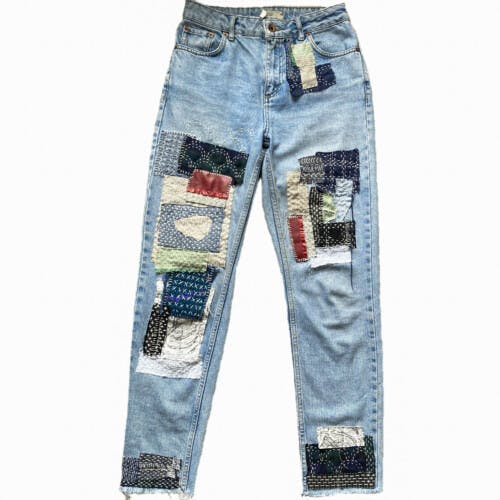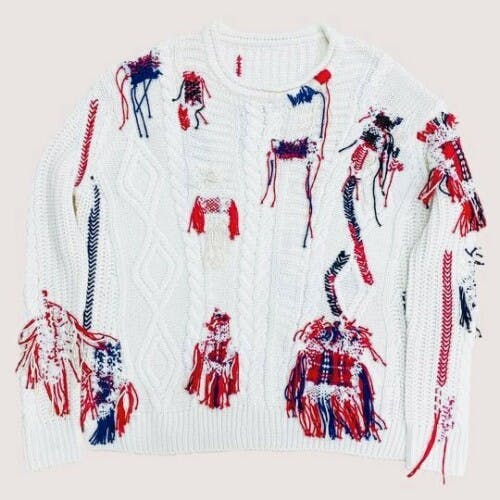Environmental Icons: In Conversation with Hannah, Founder of Restoration London
Georgia Taylor-Stidwell: Have you noticed a difference in attitudes regarding mending and sewing? If so, could you reflect on this?
Hannah: I have definitely noticed a huge rise in my sewing and mending workshops since the pandemic started. I think a lot more people are interested in fixing their clothes because they weren’t able to go to the shops and suddenly had significantly more time on their hands. Now we are able to go and socialise again. People have been crazy for in person workshops, my mending classes are always the most popular, they sell out straight away!
Mending can be such a social activity. I have had people make friends at my workshops, especially people who have just moved to London. The city can be very isolating and my workshops are a great opportunity to connect with people with similar values. I have found that people at my workshops like to share tips and even suggest other workshops, instagram accounts. I have seen people exchange numbers which are so, so cute!
GTS: Do you think mending clothes can impact their emotional significance?
H: Absolutely! Imagine you have a really beautiful jumper that has perhaps been given to you by a relative or you have had it for ages but it is being overtaken by holes and is hanging on by a thread, to mend this jumper is to keep it alive!
There is an agency in being able to mend items yourself. It is so important to upskill yourself, and once you get the hang of sewing and mending they can become quite easy and quite addictive! Now when I fix my jumpers I can’t just mend a small hole I have to customise the entire thing so it looks like a mad jumper! I get so into it I can’t put my materials down, I keep wanting to customise. The more you customise the more emotionally invested you become because you have invested so much of your time into the garment.
You arent on your phone, you aren’t on instagram, mending can help you with mindfulness as it takes you completely away from different life anxieties. Anything you do with your hands removes you from being constantly online.
GTS: What is your advice to a complete sewing newbie who wants to try mending or upcycling their clothes, where can we start?
H: Attend a workshop that is suitable for beginners! My Japanese mending workshop is great for beginners. It is easier to hold yourself accountable if you are learning in person and as I said it is super sociable! My mending kits are so beginner friendly, it is constructed completely step by step even from how to thread the needle.
GTS: Can you tell us a little bit about Japanese mending and why it is so beginner friendly?
H: Japanese mending is something I teach in person and online. I teach the two different types of mending, both Sashiko stitch and Boro stitch. Sashiko means ‘little stabs’ in Japanese and usually you use white cotton thread on indigo fabric so it is perfect for denim. The technique is called Sashiko as you use a Sashiko needle which is really long and thin, you gather the fabric onto the needle almost like a pleat and pull through in one motion. Boro is more complicated and is more about patchworking, it is all about free hand stitching and layering.
These techniques take so much labour, for example, my sample jeans are probably worth 4 or 5 hundred pounds, they are so heavy from all the fabric layered up with Boro stich and they probably have a cumulative three or four entire days of labour in them!

Hannah’s sample jeans, patched using Boro stitch
Mending is so important to understand the value of these items and the time and labour that their creation entails. I remember in the summer the Zara crochet dress controversy, Zara were selling a crochet dress for around £40-50. Crochet cannot be done by machine it has to be done by hand, I crochet as well and that dress would take me a good 4 or 5 days to create. There really is a crazy alienation between production and product, there is a long way to go for people to connect labour and the finished fashion product but learning to mend, learning the skills yourself is the best way to combat this alienation.
GTS: What is your favourite item you have made or upcycled and why? (please send a photo we would love to see)!
H: Definitely my mad jumper, I made it out of a jumper I bought in the charity shop years ago which began to fray. There were originally only two holes in the jumper, but I liked the tartan patch I used so much so I started cutting holes in the rest of it to add in more patches. I get so many compliments on that jumper.

Hannah’s ‘Mad Jumper’
At the point I made it I had not done much darning before so it was a real learning experience. I taught myself how to make different tartan patterns and different houndstooth and check patterns. I look at that piece and I think the yarn works really well, I love the colours, I just love the piece and I wear it ALL the time!
GTS: What was it that prompted you to start Restoration London?
H: After my degree I got a job at House of Holland and this really opened my eyes to how wasteful the fashion industry is. I was honestly upset and I thought I would like to make a difference. I have always liked teaching and thought this would be a good opportunity to show people how they can fix their clothes and disrupt this journey of clothes to landfill.
It is a great boost to see that you have helped someone change their fashion habits, you have educated someone and then it’s great to see all the things they made, creating crazy patchwork pieces! I love seeing and inspiring creativity.
GTS: What do you envisage for the future of fashion?
H: I envisage less and less high street fashion. Instead of the highstreet I would like to see more vintage, more independent businesses. I would LOVE to see repair stations, but keeping it still affordable – mending should be something accessible to all. I come from a very working class background and we shopped on the highstreet because it was cheap, my mum had six kids! I’d like to see a world where everything is reused and there are no more of these plasticy fabrics which take thousands of years to biodegrade. I would like to see much greater circularity in the fashion industry.
Repairing and mending have got to be the future.
Click here to check out the available Restoration London events!